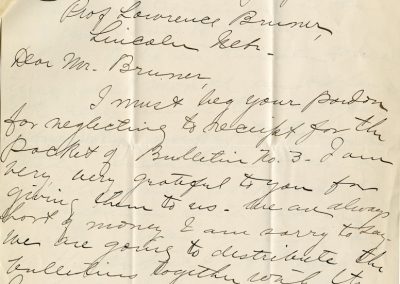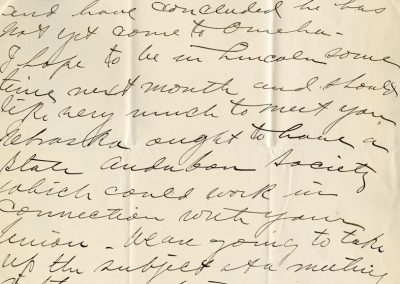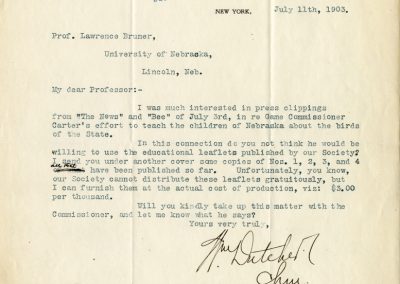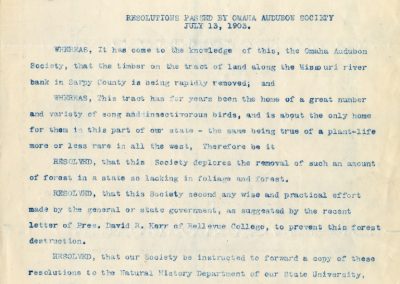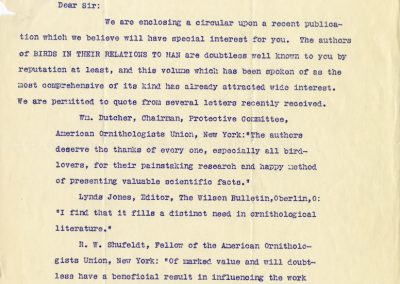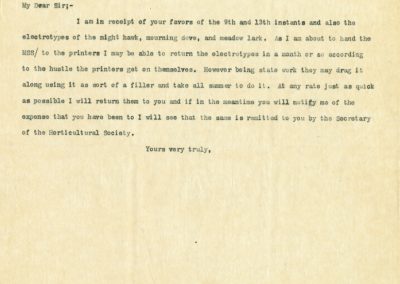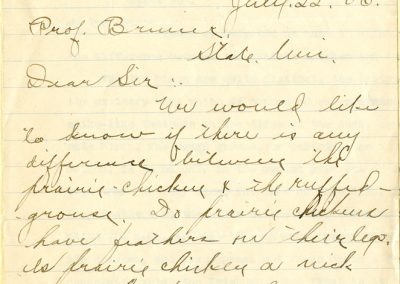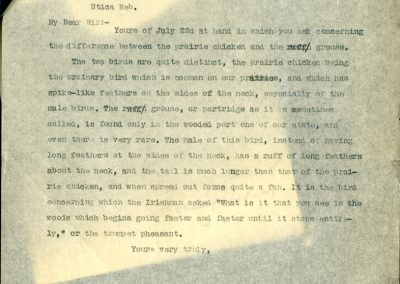Great Nebraska
Naturalists and ScientistsNebraska Ornithologists’ Union
Letters, 1903, July
1903, July 10
Dr. S. R. Towne, President MIss Joy Higgins, Secretary The Omaha Audubon Society. For the Protection of Birds. 544 South Thirtieth Street Omaha, July 10″ 1903
Prof. Lawrence Bruner Lincoln Nebr. Dear Mr. Bruner, I must beg your pardon for neglecting to receipt for the packet of Bulletin No 3. I am very very grateful to you for giving them to us. We are always short of money I am sorry to say. We are going to distribute the bulletins together with the leaflet on the Meadowlark. I am deeply grateful to you for speaking to the Game Warden & reporting the cases. I did not see Mr. Simkins
and have concluded he has not yet come to Omaha. I hope to be in Lincoln some time next month and should like very much to meet you. Nebraska ought to have a State Audubon Society which could work in connection with your Union. We are going to take up the subject at a meeting in the near future. I enclose postage for the packet, and again thank you. Very Sincerely,Joy Higgins
1903, July 11
American Ornithologists’ Union. Founded 1883. Incorporated 1888. William Dutcher, Chairman, Protection Committee, North American Birds, 525 Manhattan Avenue, New York City.
Map showing (shaded) States having Audubon Societies. Map showing (shaded) States which have adopted the A.O.U. model law protecting the non-game birds.
Dec 8 Ans’d New York, July 11th, 1903.
Prof. Lawrence Bruner, University of Nebraska, Lincoln, Neb.
My dear Professor:- I was much interested in press clippings from “The News” and “Bee” of July 3rd, in re Game Commissioner Carter’s effort to teach the children of Nebraska about the birds of the State. In this connection do you not think he would be willing to use the educational leaflets published by our Society? I send you under another cover some copies of Nos. 1, 2, 3, and 4 all that have been published so far. Unfortunately, you know, our Society cannot distribute these leaflets gratuitously, but I can furnish them at the actual cost of production, viz: $3.00 per thousand. Will you kindly take up this matter with the Commissioner, and let me know what he says? Yours very truly, Wm. Dutcher Chm.
1903, July 13
Dr. S. R. Towne, President Miss Joy HIggins, Sec
The Omaha Audubon Society, For the Protection of Birds 544 South Thirtieth Street
Omaha, 190
RESOLUTIONS PASSED BY OMAHA AUDUBON SOCIETY JULY 13, 1903.
WHEREAS, It has come to the knowledge of this, the Omaha Audubon Society, that the timber on the tract of land along the Missouri river bank in Sarpy County is being rapidly removed; and
WHEREAS, This tract has for years been the home of a great number and variety of song and insectivorous birds, and is about the only home for them in this part of our state – the same being true of a plant-life more or less rare in all the west, Therefore be it
RESOLVED, that this Society second any wise and practical effort made by the general or state government, as suggested by the recent letter of Pres. David R. Kerr of Bellevue College, to prevent this forest destruction.
RESOLVED, that our Society be instructed to forward a copy of these resolutions to the Natural History Department of our State University, and also to the Department of Agriculture of the United States at Washington.
Pres. S. R. Towne, M.D. Secy. Joy Higgins
1903, July 15
London
5, Henrietta Street, Covent Garden
J. B. Lippincott Company
Publishers
Washington Square
Philadelphia 7/15/03
Prof. L. Bruner,
Dear Sir:
We are enclosing a circular upon a recent publication which we believe will have special interest for you. The authors of BIRDS IN THEIR RELATION TO MAN are doubtless well known to you by reputation at least, and this volume which has been spoken of as the most comprehensive of its kind has already attracted wide interest. We are permitted to quote from several letters recently received.
Wm. Dutcher, Chairman, Protective Committee, American Ornithologists Union, New York: “The authors deserve the thanks of every one, especially all bird-lovers, for their painstaking research and happy method of presenting valuable scientific facts.”
Lynda Jones, Editor, The Wilson Bulletin, Oberlin, O: “I find that it fills a distinct need in ornithological literature.”
R. W. Shufeldt, Fellow of the American Ornithologists Union, New York: “Of marked value and will doubtless have a beneficial result in influencing the work of the large body of bird protectors.”
Very truly yours,
J. B. Lippincott Company.
C. W.
We shall be glad to have your order for his book, blank for which you will find on back of circular.
1903, June 18
Lincoln, Nebr., June 18, 1903.
Mr. Wm. Dutcher,
525 Man. Ave. N. Y.
My Dear Sir:-
I am in receipt of your favors of the 9th and 13th instants and also the electrotypes of the night hawk, mourning dove, and meadow lark. As I am about to hand the MSS/ to the printers I may be able to return the electrotypes in a month or so according to the hustle the printers get on themselves. However being state work they may drag it along using it as sort of a filler and take all summer to do it. At any rate just as quick as possible I will return them to you and if in the meantime you will notify me of the expense that you have been to I will see that the same is remitted to you by the Secretary of the Horticultural Society.
Yours very truly,
1903, July 22
JUL 30 Ansd Utica, Nebr. July 22, 03
Prof Bruner, State Uni. Dear Sir: We would like to know if there is any difference between the prairie chicken & the ruffed grouse. Do prairie chickens have feathers on their legs. Is prairie chicken a nick name for ruffed grouse. Hoping to hear soon. Truly Yours Marion Nelson
1903, July 31
July 31, 1903
Mr Marion Nelson, Utica, Neb. My Dear Sir:- Yours of July 22 at hand in which you ask concerning the difference between the prairie chicken and the ruff/ grouse. The two birds are quite distinct, the prairie chicken being the ordinary bird which is common on our prairies, and which has spike-like feathers on the sides of the neck, especially of the male birds. The ruff/ grouse, or partridge as it is sometimes called, is found only in the wooded port ons of our state, and even there is very rare. The male of this bird, instead of having long feathers at the sides of the neck, has a ruff of long feathers about the neck, and the tail is much longer than that of the prairie chicken, and when spread out forms quite a fan. It is the bird concerning which the Irishman asked “What is it that you see in the woods which begins going faster and faster until it stops entirely,” or the trumpet pheasant. Yours very truly,
